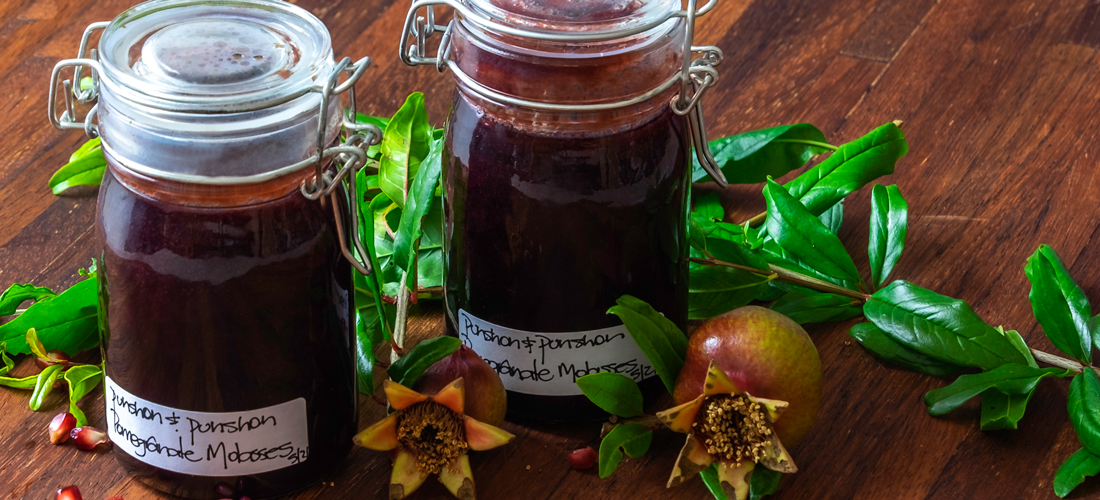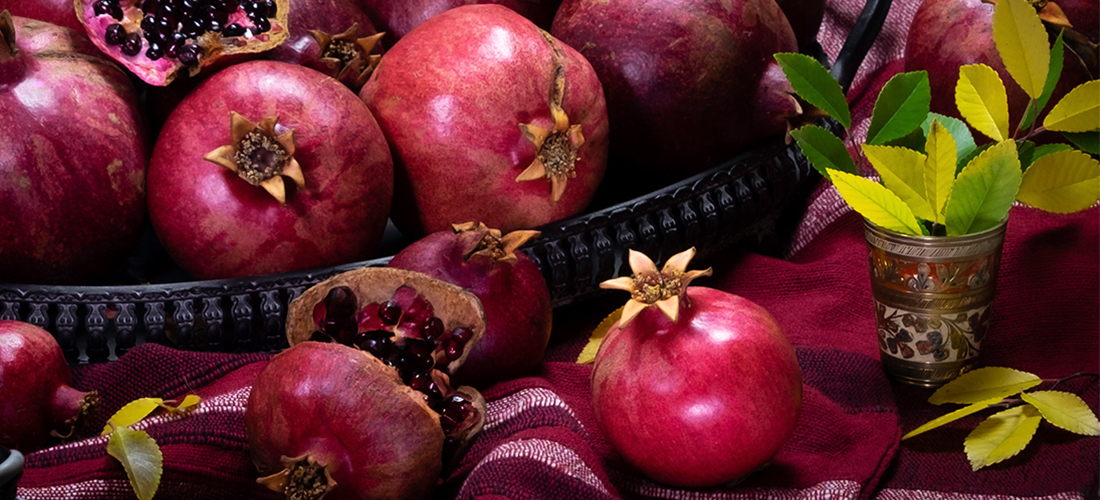Pomegranate Molasses
- Pickles, Chutney, Relish & Sauces

This wonderfully vibrant and intense syrup is made by simmering fresh pomegranate and lemon juice with a touch of sugar. The long slow simmer condenses the refreshing flavour of pomegranates and lemons to produce the quintessential Middle Eastern pantry staple. Its versatility to dress up desserts, as an accompaniment or pour-over on cakes, custards, cheesecake, ice-cream and pancakes or waffles, or as an addition to dressings, sauces and vinaigrettes and to white and red meat dishes is outstanding.
A little bit goes a long way. Just as the Italians play creatively with the sweet-tangy-acidic flavour of their beloved balsamic vinegar across sweet and savoury dishes, pomegranate molasses is just as eloquent and defines Middle Eastern culture. Enjoy your own culinary play.
An abundant pomegranate harvest will produce enough for your pantry and a few spare precious bottles for gifts.
- Preparation Time:
- 60 minutes
- Cooking Time:
- 60 minutes
- Quantity:
- 2 x 250 ml bottles
PREPARATION
Sterilise sealable glass jars or bottles and lids

INGREDIENTS
- 1.5 litres
- Pomegranate juice, fresh
- 315g
- Caster sugar
- 100ml
- Lemon juice, freshly squeezed

METHOD
In a wide heavy bottom stainless steel saucepan, combine fresh pomegranate juice, caster sugar and lemon juice. Place pan on medium-high heat and stir until sugar is completely dissolved.
Reduce heat and simmer gently uncovered for approximately 45 minutes or until mixture is reduced to approximately a third of the original volume. It should be syrupy and coat the back of the spoon.
During this simmering process, using a metal spoon or ladle remove the scum occasionally and discard. This is the foam that accumulates on top of the molasses as it simmers.
As the pomegranate molasses condenses, reduce the heat as required, to retain a gentle simmer. The syrup should be reduced to about 500 ml. Do not over reduce at this stage. Refer the Notes section below.
-
When cooked to the right consistency, remove from the heat and place saucepan on a heat-proof surface. Using a funnel pour into warm dry sterilised screw cap sealable jars/bottle. Fill to approximately 2.5cm (1inch) from the top and seal using your preferred method.
-
Label and store. If the molasses is not heat processed it can be stored for up to 4 weeks in the fridge. Processing, by using either the Preserving Unit Method or the Stock Pot Method as listed in the Notes section below, will increase its shelf life and can be stored in the pantry before opening. Once opened, store in the fridge.
NOTES
- The amount of sugar and lemon juice is indicative only as pomegranate varieties, growing conditions and degree of ripeness when picked affect their acidity and sweetness. Add more or less sugar and /or lemon juice according to your taste.
- Jars can be sterilised prior to use and stored in a clean dry, hygienic place until required. To warm, place bottles on tray and put into a preheated 100 degree C oven for 15 minutes.
- Remove from the oven and place on a wooden board or cake rack. Do not place warmed jars directly onto a cold surface as sudden changes in temperature can cause glass to crack.
- Pomegranate molasses can be made with bottled pomegranate juice; however, it will not have the same vibrant colour and flavour that fresh juice produces.
- The cooking time will vary depending upon the size and width of the saucepan, cooking temperature and if the recipe volume is increased or decreased.
- Do not over-reduce the syrup as this will increase the likelihood of burning the molasses and /or increasing its bitterness.
- The molasses will thicken slightly as it cools.
- The pomegranate molasses can be preserved to increase its shelf life by using either the Preserving Unit Method or the Stock Pot Method. The principles are the same. The difference is a preserving unit will have an internal removable rack for bottles to sit on and a tap to easily draw off the water. Some units may have an in-built thermometer.
Preserving Unit Method
- Place sealed bottles/jars in Fowlers Preserving Unit or equivalent.
- Cover with water, bring to the boil and hold at gentle boil for 30 minutes.
- Turn off, remove lid, and allow to stand for 5 minutes before removing.
- Using the tap draw off some of the hot water so the level is sufficiently below the bottles to be able to safely remove them without scalding yourself.
- Remove from hot water bath and place on a board to cool.
Stock Pot Method
- Line large stock pot with some sheets of newspaper or a cut-down cake rack. Place the bottles on the newspaper or rack, in the pot, allowing space between each bottle so they do not touch. This lining will protect the bottles from direct heat and prevent cracking.
- Cover with water, bring to the boil and hold at gentle boil for 30 minutes.
- Turn off, remove lid, and allow to stand for 5 minutes before removing.
- If possible, remove some of the hot water so the level is sufficiently below the bottles to be able to safely remove them without scalding yourself.
- Remove from hot water bath and place on a board to cool.
How to make Fresh Pomegranate Juice: 1 Pomegranate yields appx 1/2 cup juice
- Making pomegranate juice is simple and easy. Removing the seeds can be time consuming but the result is definitely worth it. Experienced pomegranatarians will have their favourite extraction method.
- My method.
- Using a sink strainer plug fill the sink half full of cold water.
- Cut the fruit into quarters and working with a quarter at a time, pull the white membrane apart. Some seeds might need gentle encouragement. The seeds will fall to the bottom and the membrane will float.
- Skim across the water with a strainer to remove the membrane. Drain the sink, the sink strainer plug will prevent the seeds from being washed away.
- If using a juicer. Place the seeds in the juicer, turn on and watch the juicer squeeze the juice from the ruby sac surrounding each seed. Discard the seeds (preferably in the compost) and use the juice as required.
- If using a blender. Place the seeds in the blender and pulse quickly. The blender will chop the seeds while releasing the juice. Pour through a fine strainer to separate the seeds and juice. if it is over blended the juice will contain finely ground course seed. This causes a bitter flavour and unpleasant texture. Discard the seeds (preferably in the compost) and use the juice as required.
Variations
This traditional recipe can be vamped up with a selection of your favourite spices. For example cinnamon quills, whole cloves,and or cracked cardamom seeds can be added after the sugar has been dissolved. Taste during the cooking to adjust spice mixtures or remove if their flavour starts to dominate.

